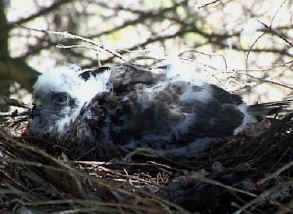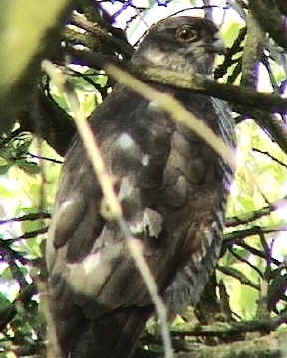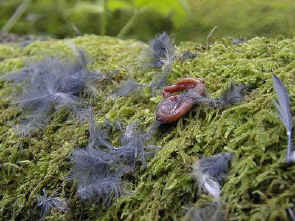Sparrowhawk
Accipiter nisus
WEBCAM & MOVIE LINK AT THE BOTTOM OF THIS PAGE
|
Sparrowhawks are small birds of prey typically
between 30 - 40cm tall with a wingspan of 60 - 80cm. The males are smaller than the female
which is shown on the left. The female weighs between 270 and 310 grams. The males are one
third smaller. The male has a grey back and the female is brown. Both birds have
distinctive light coloured fronts with horizontal brown bars. As the name suggests Sparrowhawks predate upon small birds. They do not normally catch any other prey. Thus their numbers are largely controlled by the size of the song bird populations. The larger females will sometimes catch prey the size of Woodpigeons. The male has difficulty with birds much bigger than Tits. |
| They are spectacular fliers. Whilst they may be seen soaring they can also be seen flying down a hedge row at speed. At the same time they will swoop down to one side of the hedge and then the other in an effort to frighten out the small birds which instinctively take cover when a sparrowhawk is about. At other times they will fly just above the surface of a road before disappearing through what appears to be a tiny gap in the roadside vegetation. However it is in woodland that they excel. Their excellent flying ability enables them to ambush unsuspecting birds. | |
|
They then pluck their prey usually at a favourite stump known as a plucking perch. Often this is the only sign that they are present in a locality as this woodland bird spends much of its time sitting motionless in deep cover. Each adult consumes about 2 small birds a day. However because of their secretive nature they are often more common than one might think and nest at a maximum density of 5 - 6 pairs per square mile where the habitat is suitable |
| Sometimes you can hear the alarm calls of birds such as Blackbirds as the anxious parents try to distract the sparrowhawks attention if it is near the nest. The male blackbird in this AVI can be seen perilously close to a female sparrowhawk as it tries to defend its nest by a mixture of display and sound. Meanwhile the vocal female blackbird displays on a nearby branch AVI. Other birds such as crows and rooks will also mob a sparrowhawk if it is out in the open. | |
 |
Sparrowhawks nest in May laying about 4 or 5 eggs. They are incubated for 35 days. Upon hatching the female remains on the nest for the first two weeks. During this time the male does the hunting. Most of the prey is made up of tits and chaffinches as the young of these species will have left the nest and are therefore abundant. The male does not feed the young. The female takes the prey from the male. |
| She then breaks it up and feeds it to the small white fluffy chicks. When the chicks are about 3 weeks old they are able to feed themselves and the female will leave the nest and hunt for prey. Up to 10 small birds will have to be caught by the parents every day if all the chicks are to survive. At about 28 days old the young will start to clamber out of the nest and sit on the nearby branches. They can be very vocal at this time. By August they can look after themselves and disperse from the nest site. However they usually remain within 10 miles. | |
Sparrowhawk eats its prey - movie
(Broadband connection required - movie courtesy
Craig Mansfield)

